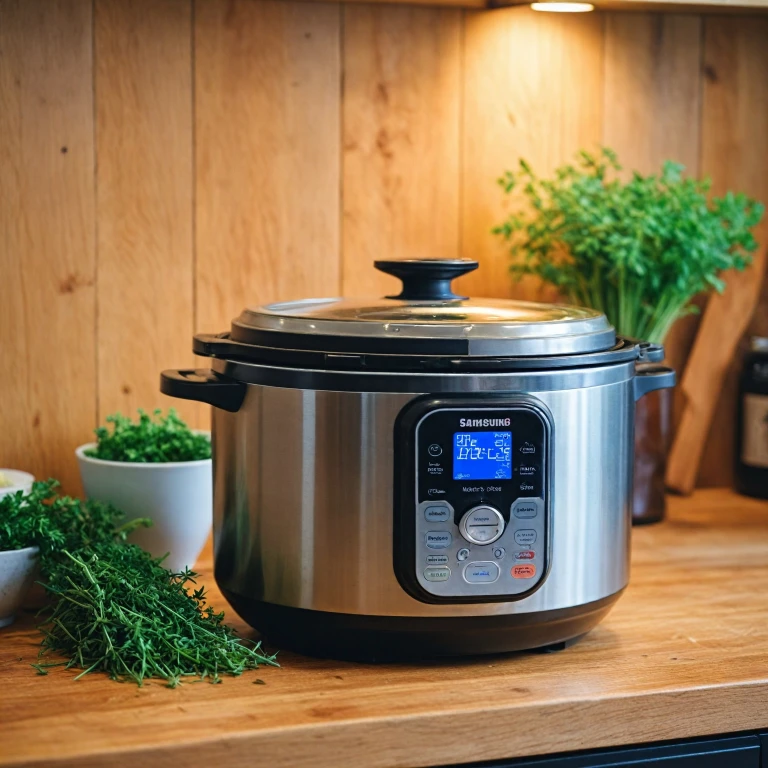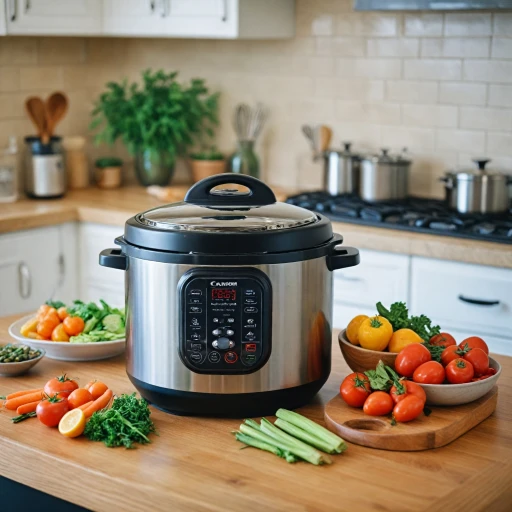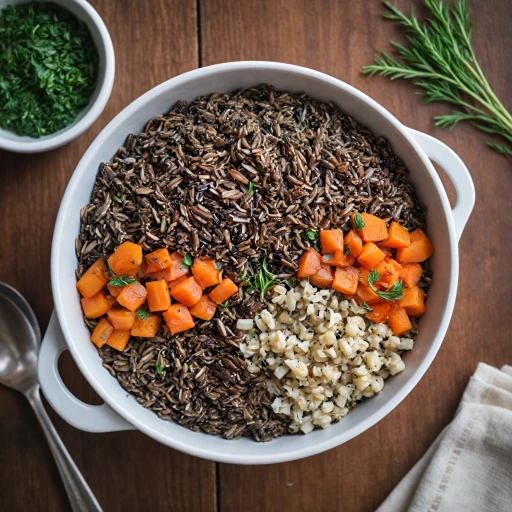Understanding the Instant Pot
Getting to Know Your Instant Pot
The Instant Pot has revolutionized the way we approach cooking, especially when it comes to preparing rice dishes like basmati rice. This versatile kitchen appliance combines the functions of a pressure cooker, slow cooker, rice cooker, steamer, sauté pan, and even a yogurt maker. For those looking to master the art of cooking basmati rice, understanding the Instant Pot's features is crucial.
Why Use an Instant Pot?
One of the main advantages of using an Instant Pot is its ability to cook food quickly and evenly. When it comes to basmati rice, the pressure cooking function ensures that each grain is cooked to perfection, maintaining the delicate texture and aroma that basmati is known for. Additionally, the Instant Pot's sealed environment prevents moisture loss, which is essential for achieving the ideal rice water ratio.
Key Features for Cooking Basmati Rice
- Pressure Settings: The high pressure setting is ideal for cooking basmati rice, as it reduces cooking time to just a few minutes while ensuring even cooking.
- Timer Function: This feature allows you to set the exact cooking time, making it easier to follow your favorite rice recipe.
- Pressure Release: Understanding the difference between natural and quick pressure release is essential. Natural release can enhance the texture of your cooked rice.
Preparing for Success
Before diving into your basmati rice recipe, make sure to rinse rice thoroughly. This step removes excess starch, which can lead to sticky rice. Additionally, measuring the correct cups of water is vital for achieving the perfect consistency. Typically, a 1:1.25 cup water ratio works well for basmati rice in an Instant Pot.
For more insights on how to optimize your rice cooking experience, consider exploring how you can cook minute rice in a rice cooker, which offers a different perspective on rice preparation. This knowledge will enhance your overall understanding of cooking rice using various methods.
The Science Behind Cooking Basmati Rice
The Chemistry of Basmati Rice
Cooking basmati rice in an Instant Pot involves a fascinating interplay of water, heat, and pressure. Understanding these elements can help you achieve perfectly cooked rice every time. The Instant Pot, a versatile pressure cooker, uses high pressure to cook food faster than traditional methods. This rapid cooking process is ideal for basmati rice, which requires careful attention to water ratio and cooking time.
Water Ratio and Its Importance
The water ratio is crucial when cooking basmati rice in a pressure cooker. Typically, a 1:1.5 ratio of rice to water is recommended. This means for every cup of basmati rice, you should add one and a half cups of water. This ratio ensures that the rice absorbs the right amount of moisture, resulting in fluffy, separate grains.
Pressure Cooking Dynamics
When you pressure cook basmati rice, the high pressure reduces the cooking time significantly. Generally, it takes about 4 to 6 minutes under high pressure to cook the rice perfectly. After the cooking time, a natural pressure release helps the rice finish cooking gently, preventing it from becoming mushy.
Role of Rinsing
Rinsing basmati rice before cooking is a step that should not be overlooked. Rinsing removes excess starch, which can cause the rice to become sticky. By rinsing the rice until the water runs clear, you ensure that each grain cooks separately, enhancing the overall texture.
Temperature and Pressure Release
The temperature and pressure within the Instant Pot play a significant role in cooking basmati rice. High pressure allows the temperature to rise above boiling point, cooking the rice faster. After the cooking cycle, allowing a natural pressure release for about 10 minutes helps the rice settle, ensuring it is perfectly cooked without being overdone.
By understanding these scientific principles, you can avoid common mistakes and enhance your basmati rice experience, ensuring each grain is perfectly cooked every time.
Step-by-Step Guide to Perfect Basmati Rice
Gathering Your Ingredients and Tools
To achieve perfect basmati rice in your Instant Pot, start by gathering all the necessary ingredients and tools. You'll need basmati rice, water, and salt. For a standard recipe, use 1 cup of basmati rice to 1.25 cups of water. This water ratio is crucial for achieving the right texture. Ensure your Instant Pot is clean and ready for use.
Rinsing the Rice
Rinsing basmati rice is an essential step to remove excess starch, which can make the rice sticky. Place the rice in a fine mesh strainer and rinse under cold water until the water runs clear. This process will help you achieve fluffy, separate grains.
Setting Up the Instant Pot
Once your rice is rinsed, add it to the Instant Pot along with the measured water and a pinch of salt. Secure the lid and set the valve to the sealing position. Select the 'Pressure Cook' or 'Manual' setting on high pressure, and set the time to 6 minutes. This is the optimal time for cooking basmati rice in an Instant Pot.
Pressure Cooking and Release
After the cooking time is complete, allow the pressure to release naturally for about 10 minutes. This gradual pressure release helps the rice finish cooking and prevents it from becoming mushy. After 10 minutes, carefully switch the valve to the venting position to release any remaining pressure.
Fluffing and Serving
Once the pressure is fully released, open the lid and gently fluff the rice with a fork. This step helps separate the grains, ensuring they remain light and fluffy. Your perfectly cooked basmati rice is now ready to serve as a side dish or as a base for your favorite recipes.
Common Mistakes and How to Avoid Them
Overcoming Common Pitfalls
Cooking basmati rice in an instant pot can be a game-changer, but it's easy to make mistakes that affect the final result. Here are some common pitfalls and how to avoid them to achieve perfect basmati rice every time.
Incorrect Water Ratio
One of the most frequent errors is using the wrong water ratio. For perfect basmati rice, the standard is 1 cup of rice to 1.25 cups of water. Too much water will make the rice mushy, while too little can leave it undercooked. Adjust the water ratio according to your specific instant pot model and personal preference.
Skipping the Rinse
Rinsing the rice before cooking is crucial. It removes excess starch that can cause the rice to become sticky. Rinse the rice under cold water until the water runs clear to ensure fluffy, separate grains.
Ignoring Pressure Release
Proper pressure release is key to achieving the right texture. Allow the pressure to release naturally for about 10 minutes before switching to quick release. This gradual process helps the rice settle and prevents it from becoming too dry or clumpy.
Timing Mistakes
Cooking time is another critical factor. Set your instant pot to high pressure and cook the rice for 6 minutes. Any deviation can result in undercooked or overcooked rice. Remember, the time includes the pressure build-up and release, so plan accordingly.
Not Adding Salt
While it might seem minor, adding a pinch of salt enhances the flavor of the rice. It’s an easy step that can significantly improve your rice recipe.
By understanding these common mistakes and how to avoid them, you can ensure that your basmati rice turns out perfect every time. Remember, practice makes perfect, and with a little attention to detail, you’ll master the art of cooking basmati rice in your instant pot.
Enhancing Your Basmati Rice Experience
Elevate Your Basmati Rice with Flavorful Additions
Once you've mastered the basics of cooking basmati rice in your instant pot, it's time to enhance your experience by experimenting with flavors and textures. Adding a few ingredients can transform your rice into a delightful dish.
- Spices and Herbs: Consider adding a pinch of saffron, cumin, or cardamom to your rice water before pressure cooking. These spices will infuse your basmati rice with a rich aroma and taste.
- Broth Instead of Water: Replace water with chicken or vegetable broth to add depth to the flavor. This simple swap can make your rice more savory and satisfying.
- Nuts and Dried Fruits: Stir in toasted almonds, cashews, or raisins after the pressure release. These additions provide a delightful crunch and sweetness that complements the soft texture of the rice.
- Fresh Herbs: Garnish your cooked rice with fresh cilantro or parsley. The vibrant colors and fresh flavors will enhance the visual appeal and taste of your dish.
Perfecting the Water Ratio for Fluffy Rice
Achieving the perfect texture for basmati rice often depends on the correct water ratio. Typically, a 1:1.5 ratio of rice to water works well. However, this can vary based on the age and quality of the rice. Adjusting the water ratio slightly might be necessary to achieve the fluffiness you desire.
Timing is Key
Cooking time is crucial for perfect basmati rice. Generally, pressure cooking on high pressure for about 4 to 6 minutes followed by a natural pressure release ensures the rice is cooked evenly. Keep an eye on the time and adjust if needed based on your preferences and previous results.
Experiment with Different Recipes
Don't hesitate to try various rice recipes using your instant pot. From pilafs to biryanis, the possibilities are endless. Experimenting will not only enhance your cooking skills but also make meal times more exciting.
Troubleshooting Instant Pot Issues
Addressing Common Instant Pot Challenges
Even seasoned cooks can encounter hiccups when using an Instant Pot. Here are some frequent issues and solutions to keep your basmati rice cooking experience smooth and enjoyable.
Pressure Build-Up Delays
Sometimes, it feels like the Instant Pot takes forever to start cooking. This delay often results from insufficient liquid or too much food in the pot. Ensure you have the right water ratio; for basmati rice, a common recommendation is 1 cup of rice to 1.25 cups of water. This allows the pressure to build efficiently.
Burn Notice
The dreaded 'burn' notice can halt your cooking process. To avoid this, make sure to rinse the rice thoroughly before cooking. This removes excess starch that can cause sticking. Also, ensure there's enough liquid in the pot and avoid stirring the rice and water before sealing the lid.
Undercooked or Overcooked Rice
Getting the perfect basmati rice can be tricky. If your rice is undercooked, add a bit more water and cook for a few extra minutes. For overcooked rice, reduce the cooking time by a minute or two next time. Remember, the pressure release method affects the texture; a natural release is gentler and often preferred for basmati.
Sealing Ring Issues
If your Instant Pot isn’t sealing properly, check the sealing ring. It should be snugly fitted and free of any food residue. A loose or damaged ring will prevent the pot from reaching high pressure.
Stuck Lid
After cooking, if the lid won’t open, ensure the pressure has been fully released. Sometimes, the float valve can stick; gently tap it to ensure it drops, allowing you to open the lid safely.
By understanding these common issues, you'll be better equipped to handle them and ensure your basmati rice turns out perfect every time. With practice, your Instant Pot will become an invaluable tool in your kitchen arsenal.







